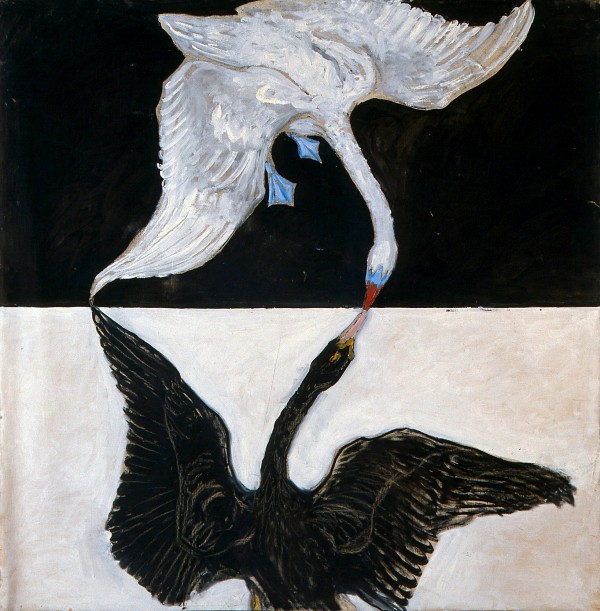
*Painting by Hilma af Klint, 1862-1944.
Those who have been longtime readers of this blog know that I have an affinity for late 19th and early 20th century painting. I also am quite fond of reading about the artist's lives, in great part because some of them were really wild folks. In addition, the vast majority of my favorites were interested in "Eastern" religion and philosophy, to the point where their artwork is influenced to a greater or lesser extent by it. In addition, in terms of this blog, this time period was the beginning of more deliberate movement of Buddhists and Buddhist teachings to North America and Europe, and thus is important for developing an understanding of the ways in which teachings, rituals, cultural and religious structures were adapted in response to new surroundings, both by Asian immigrant Buddhists and by the mostly white North American and European types who either studied, cherry picked, or eventually converted to Buddhism.
Swedish artist Hilda af Klint was, like many others of the period, influenced primarily by the teachings of Theosophy. In a lot of ways, theosophy paved the way for the New Age movement, especially with it's emphasis on blending spiritual and religious teachings and focus on the evolution of consciousness. It's an interesting, if odd mixture of things, and certainly one can argue that Blavatsky and others cherry picked and culturally appropriated a myriad of traditions to suit their needs. However, it also can be viewed as the spirited, if overreaching reaction of spiritual people to a world that suddenly was becoming globally connected right before their eyes. We are in a similar period now, with the internet and other technology, making the gap between nations even smaller - and in the process, shaking up the entire way we - as humans - understand and interact.
Klint was, by all accounts, a sane and balanced artist, who also happened to be regarded as a clairvoyant, driven to paint by an unseen "guide," and whose art somehow repeatedly anticipated and demonstrated principles that would appear years later on the canvases of famed European and American modernists and abstractionists. In addition, she was fairly secretive about her work, showing little of it publicly during her life. Her dying wish, in fact, was that her paintings not be shown in public for twenty years. Perhaps she wondered if people would be able to handle them.
Several of her paintings have to do with the integration or merger of two figures, or dualities. Of this, Ronald Jones and Liv Stolz wrote:
Between 1906 and 1915 she completed ‘Paintings for the Temple’ (182 paintings divided into a number of different series) in which she sought to represent the path towards the reconciliation of spirituality with the material world, along with other dualities: faith and science, men and women, good and evil.
I have often felt that a central feature of our life's work, and which is demonstrated in Buddha's teachings, is reconciling ourselves with the myriad of dualities at play in our lives.
In addition, it's interesting to consider that Klint often painted following a period of meditation. Yes, her meditation probably looked little like "our" meditation, but that's of secondary note in my view. What's fascinating is the merger of meditation with a focus on reconciling the opposites, something Buddhists can certainly appreciate, if anything.
I suppose some of you might be thinking. Ok, so what? Well, even if you could care less about art or weird occult stuff, there is still something worth considering from a Buddhist practitioner standpoint. Late 19th and early 20th century white Westerners who ended up adopting Buddhism were products of this time. For better or worse, they were influenced by the synthesizing processes present in both the philosophies of the time (such as theosophy), as well as the art of the time (which included more famous artists influenced by synthesized spirituality. Searching for the "essence" of traditions, and "stripping away cultural baggage," two highly contested issues amongst contemporary Western Buddhist circles, were the calling cards of the day back then. People wound up about Stephen Batchelor and friends today might consider that Henry Steel Olcott, one of the first white convert Buddhists, was merging Buddhist teachings with Western science, philosophy, and rationalism, over 120 years ago.
In other words, issues that seem to be the product of our current wave of Buddhist expansion have their roots in the past. So, while we continue to struggle with defining what it is that we mean by Buddhism in the West, perhaps it would be valuable to go further back in time, and consider more thoroughly how the planks we stand on today were laid. And if nothing else, there is plenty of beautiful artwork and interesting life stories just waiting to be re-discovered.
4 comments:
What an interesting piece. My first hit on seeing it was that it reminded me so much of the ying yang symbol, with the interplay of light and dark.
I suspect that all artists at some point are engaged in a "meditative" process and that the process consists as much of listening as anything.
I think all serious art is by nature spiritual. And that all spirituality at it's core level is the same.
"I think all serious art is by nature spiritual. And that all spirituality at it's core level is the same." I agree.
And yes, the yin/yang symbol.
I enjoyed reading this, and am re-posting it at our site.
Jon C.
buddhistartnews.wordpress.com
cool website! Thanks for including my post.
Post a Comment